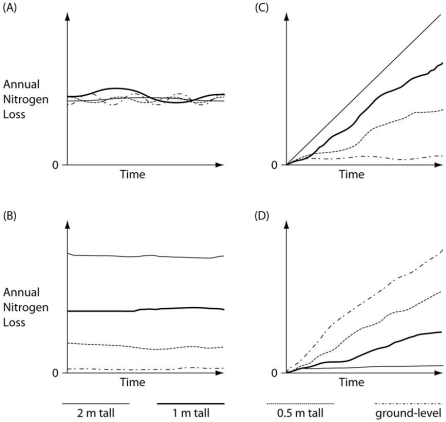Refer to the following information to answer the next few questions.
Researchers decided to test the hypothesis that if the 2-m tall Polytrichum gametophyte- sporophyte plants had acted as a physical buffer, then they would have reduced water's ability to erode the soil and carry away its nitrogen. They began with four equal-sized areas where Polytrichum mosses grew to a height of 2 m above the soil surface. One of the four areas was not modified. In the second area, the mosses were trimmed to a height of 1 m above the soil surface. In the third area, the mosses were trimmed to a height of 0.5 m above the soil surface. In the fourth area, the mosses were trimmed all the way to the ground, leaving only the rhizoids. Water, simulating rainfall, was then added in a controlled fashion to all plots over the course of one year. The figure below presents four graphs that depict potential results of this experiment.

-If the actual results most closely resembled those in part (A) of the figure, then a further question arising from these data is: "Do the Polytrichum rhizoids have to be alive in order to reduce soil nitrogen loss, or do dead rhizoids have the same effect?" Arrange the following steps in the correct sequence to test this hypothesis. 1. Add metabolic poison to the soil of the experimental plot of mosses.
2. Apply water equally to the experimental and control plots.
3. Measure initial soil nitrogen contents of control and experimental plots.
4. Determine nitrogen loss from soil of control and experimental plots.
5. Establish two identical plots of Polytrichum mosses; one as a control, the other as the experimental treatment.
Definitions:
Blood Ph
The measure of acidity or alkalinity of the blood, which is tightly regulated around a value of 7.4.
Apocrine Sweat Glands
Specialized sweat glands that produce a thicker, milky secretion and are typically associated with hair follicles in underarm and genital areas.
Thermoregulation
The physiological process by which an organism regulates its internal temperature within a certain range, despite external changes.
Integumentary System
The organ system consisting of the skin, hair, nails, sweat, and oil glands, providing protection to the body.
Q4: Which of the following characteristics is common
Q10: If a particular marine organism is fossilized
Q15: At which location is the mycelium currently
Q31: Among known plant species,which of these have
Q36: In which of the following human mycoses
Q45: Which of the following microsporidian features are
Q61: Refer to the paragraph on scarlet gilia.What
Q64: To which of the following are the
Q67: A P.bursaria cell that has lost its
Q82: In animal cells and in the meristem